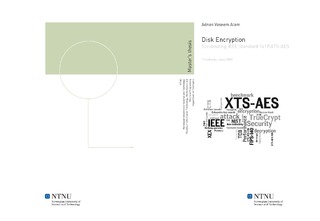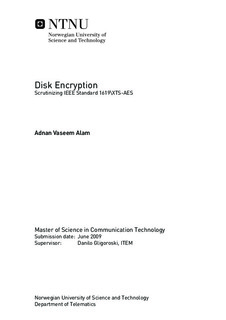| dc.description.abstract | Disk encryption has changed during the last decade from being a mechanism only used by corporate executives and government agencies for their top secret information, to become trivially feasible for everyone to utilize. One of the forces that have been driving this development is the steady flow of new cryptographic primitives such as tweakable narrow- and wide-block ciphers specifically designed for disk encryption implementations. One such tweakable narrow-block cipher is XTS-AES, which is standardized in IEEE Std 1619 and very recently accepted by NIST as an approved mode of operation for AES under FIPS-140. In the first part of this thesis, we study principles and investigate methods used in disk encryption. We present the different implementation types of disk encryption (hardware-based versus software-based, wide-block versus narrow-block, authenticated versus transparent), commonly discussed modes of operations (LRW, XEX, MCB, CMC, EME, XCB), and briefly review some open-source software implementations of disk encryption (TrueCrypt, FreeOTFE, dm-crypt). In the second part of this thesis we provide a thorough examination of XTS-AES, describing both its security and real-world performance. To our knowledge, this is the first scientific work to provide an elaborate description of XTS-AES while also assessing its real-world performance. Our work show that introducing XTS-AES-256 full system disk encryption using TrueCrypt 6.1a on Windows yield a decrease in write and read speed of up to -35% (average for Windows XP, Windows Vista, and Windows 7 Beta). Further, our results also show that disk operations that uses approximately 2% of the CPU resources when no disk encryption is present, takes up to 50% of the CPU resources when full system disk encryption is deployed. | nb_NO |

